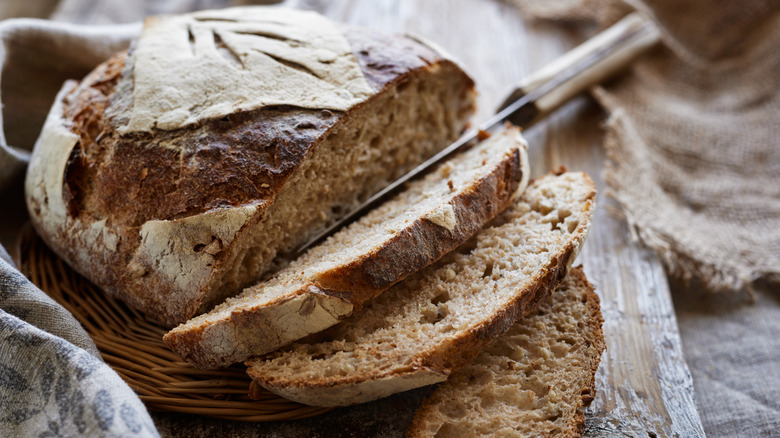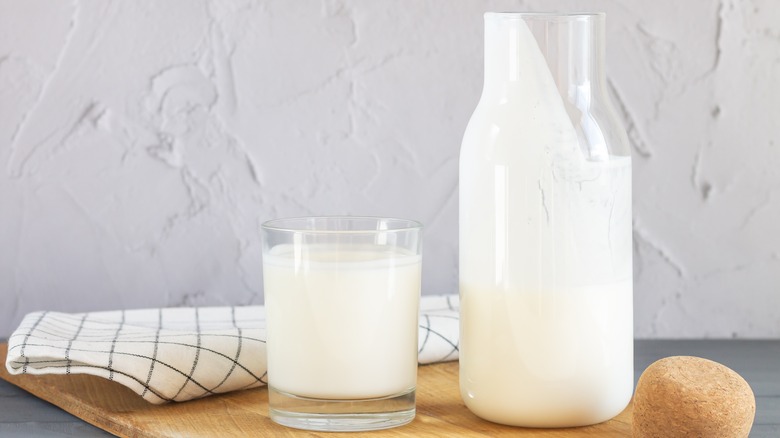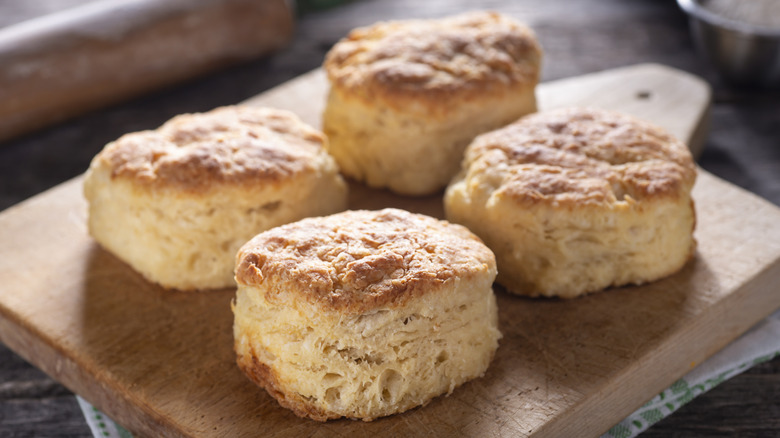Why Some Bakers Prefer To Make Bread With Sour Milk
When craving a bowl of cereal, discovering the milk is sour can really yuck your yum — almost as much as finding that milk-filled sippy cup days later in your hot car. While its tangy taste and distinct odor will likely prevent you from enjoying a tall glass with chocolate chip cookies, you don't need to dump it down the drain when it's past the expiration date. Sour milk is bakers' secret ingredient to better breadmaking.
Sour milk, or bread milk, creates a soft crumb and crust, making it ideal for sandwich bread recipes. The tangy dairy can also be used in recipes that call for regular milk or buttermilk as an ingredient, like our recipe for tender, flaky homemade biscuits. It's a natural leavening agent, so baked goods are less dense, and sour milk flavors the bread, reminiscent of sourdough.
There are varying degrees of sourness, so it's essential to understand what we mean by 'sour milk' to avoid getting sick. If your milk has a sour smell but the texture or consistency hasn't changed, you can use it for bread recipes. Once it 'plops' into the sink in clumps, it's time to buy a new container. As a side note, if you notice that the milk stored on the fridge's door is going sour quickly, it's time to change its location and place it on a shelf towards the back.
Sour milk versus buttermilk
Although the terms are sometimes used interchangeably, buttermilk and sour milk have different characteristics. Sour, expired, or spoiled milk is regular milk that has started to ferment, which means that lactic acid-forming bacteria have started to multiply. The process changes the milk's taste from sweet to sour, ultimately altering its consistency. It can be made from raw or pasteurized milk – although some people distinguish between the two, associating spoiled milk with pasteurized and sour milk with raw.
Some bakers let regular milk sit on the counter at room temperature until it intentionally spoils for breadmaking. While it's not advised to drink it raw, baking with sour milk is considered safe. Lactic acid-forming bacteria die at 160 degrees Fahrenheit, which is well past the internal temperature of a typical loaf of baked bread, between 195 and 210 degrees Fahrenheit. Still, if you are concerned about consuming sour milk, avoid using raw milk and stick with pasteurized sour milk.
Buttermilk, on the other hand, used to be the byproduct of butter making, but it's now made commercially by adding lactic acid to milk. Once opened, buttermilk will stay fresh in the refrigerator for two weeks or in the freezer for up to three months. If you don't need an entire container, you can make buttermilk at home by adding lemon juice or vinegar to whole milk. Compared to sour milk, buttermilk has a higher acidity level, which nicely balances sweetness.
Culinary uses for sour milk
Sour milk is a great way to embrace the Italian 'cucina povera' style of cooking, which reduces kitchen waste, saves money on grocery bills, and makes the most out of what you have on hand. You can substitute an equal amount of sour milk in sweet and savory baked goods recipes containing milk, buttermilk, yogurt, kefir, or sour cream. Unless specified, assume that the sour milk called for in the recipe should be made from whole milk, which has more fat and a creamier consistency than one made from skim milk. Using skim milk will vary the results.
Add sour milk to boxed cornbread to upgrade its taste and texture, and avoid making another dense banana bread by swapping the liquid in the recipe with sour milk. Replace the heavy cream in our basic scone recipe with equal parts sour milk and enjoy them for breakfast with clotted cream and jam. Or mix dried fruit, herbs, or chocolate chips into the dough and serve a delicious scone at an afternoon tea party.
Sour milk's application isn't limited to baked goods. It can also be used to make crepes, waffles, and perfect fluffy pancakes. Add some to marinades to help tenderize meat and fish or dressings and soups to add creaminess.



